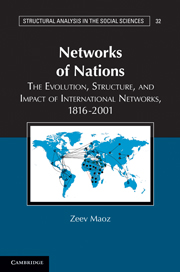Book contents
- Frontmatter
- Contents
- Preface
- Part I What Are International Networks?
- Part II The Formation of International Networks: Theory and Evidence
- Part III The Implications of the Networked International Politics Theory
- 8 Democratic Networks: Resolving the Democratic Peace Paradox
- 9 Interdependence and International Conflict: The Consequences of Strategic and Economic Networks
- 10 Evolution and Change in the World System: A Structural Analysis of Dependence, Growth, and Conflict in a Class Society
- 11 An International System of Networks: How Networks Interact
- 12 The Network Analysis of International Politics: Insights and Evidence
- Glossary
- Bibliography
- Author Index
- Subject Index
9 - Interdependence and International Conflict: The Consequences of Strategic and Economic Networks
Published online by Cambridge University Press: 05 June 2012
- Frontmatter
- Contents
- Preface
- Part I What Are International Networks?
- Part II The Formation of International Networks: Theory and Evidence
- Part III The Implications of the Networked International Politics Theory
- 8 Democratic Networks: Resolving the Democratic Peace Paradox
- 9 Interdependence and International Conflict: The Consequences of Strategic and Economic Networks
- 10 Evolution and Change in the World System: A Structural Analysis of Dependence, Growth, and Conflict in a Class Society
- 11 An International System of Networks: How Networks Interact
- 12 The Network Analysis of International Politics: Insights and Evidence
- Glossary
- Bibliography
- Author Index
- Subject Index
Summary
Introduction
This chapter focuses on structural implications of certain types of dependencies for the behavior of individual states, dyads, cliques, and systems. The key question concerns the extent to which strategic or economic interdependence affects patterns of international conflict. I also study whether the interdependence-conflict nexus is present across multiple levels of analysis. My approach to these questions is different than that taken in many studies of the subject, both within international relations and within network analysis. It represents several important innovations: First, it applies new strategies to tackle traditional ideas about influence in networks (e.g., Katz, 1953; Hubbell, 1965; Taylor, 1969). In particular, the ways in which I extend these indices are more consistent with international networks than are the more traditional approaches in SNA. Second, the novel measures of dependence and interdependence I developed and discussed in Chapter 2 allow assessment of interdependence across levels of analysis. Third, this approach allows measurement of interdependence across different types of exchange relations. Finally, it allows integration of interdependencies across multiple networks into a single set of measures.
As important as these methodological innovations may be, however, they are not the main focus of this chapter. Rather, the chapter seeks to explore the implications of strategic and economic interdependence for international relations. In particular, it examines the effects of interdependence on conflict across levels of analysis. Chapter 10 then examines differential rates of dependence and their implications for development and peace. Let us first introduce the key issues of the present chapter.
- Type
- Chapter
- Information
- Networks of NationsThe Evolution, Structure, and Impact of International Networks, 1816–2001, pp. 276 - 296Publisher: Cambridge University PressPrint publication year: 2010

